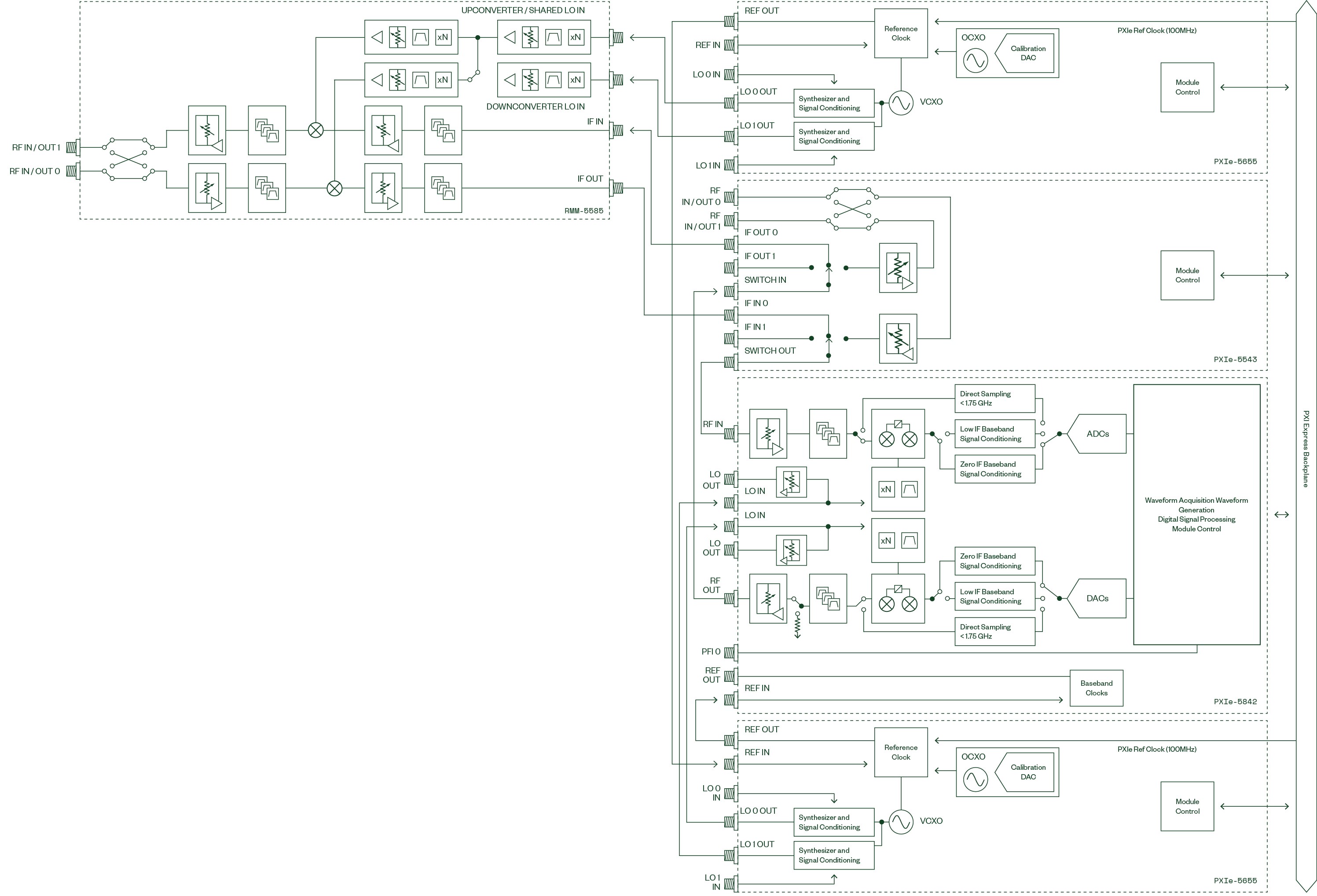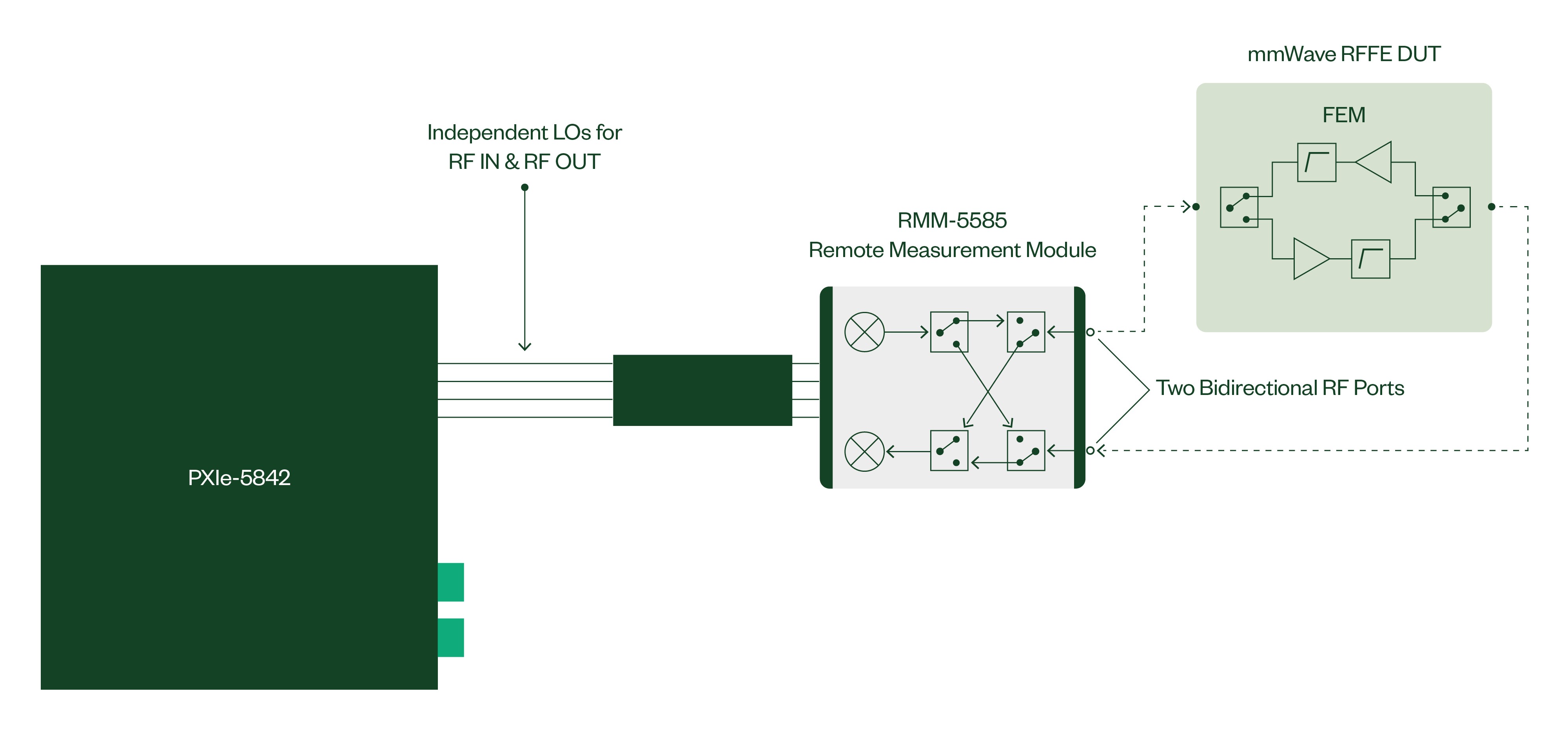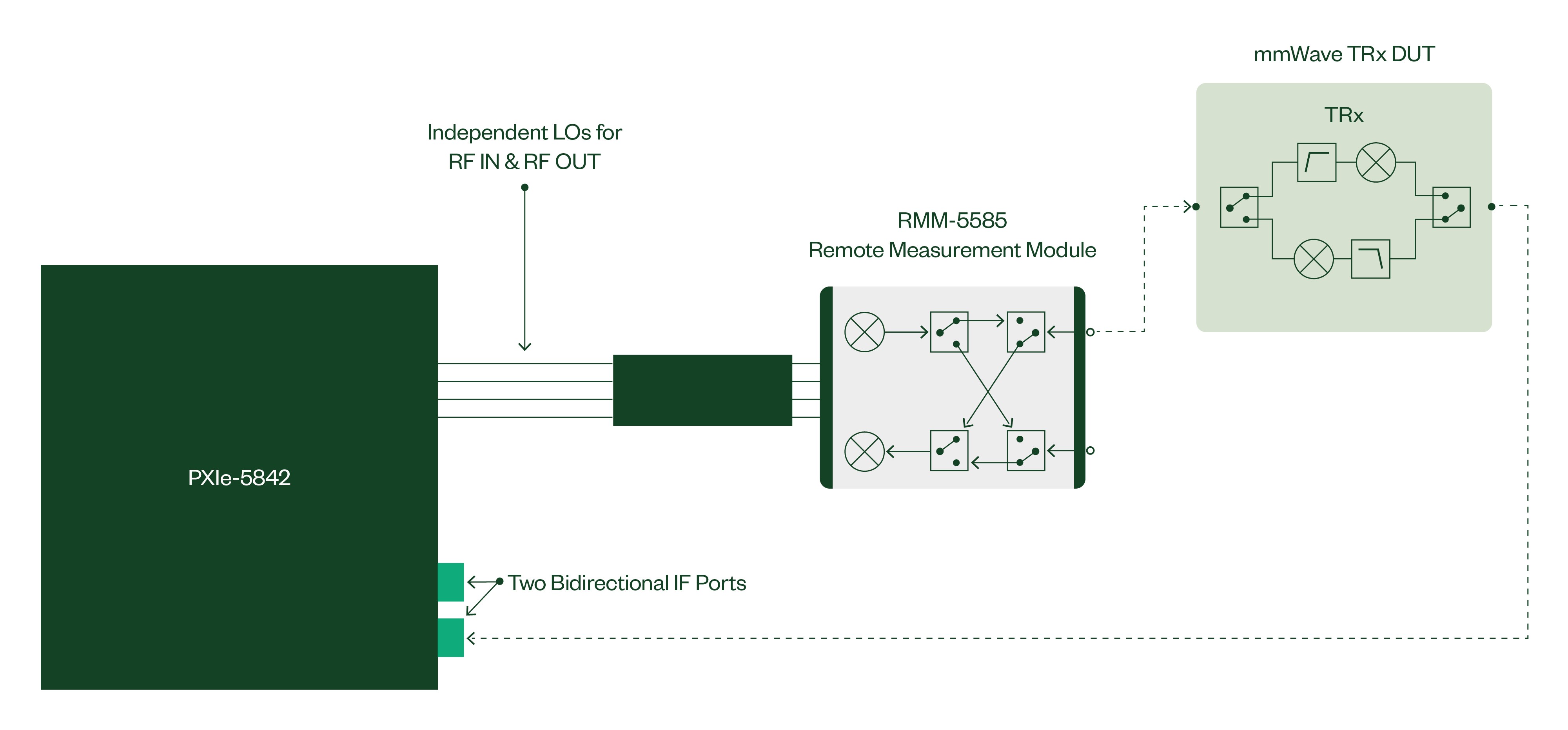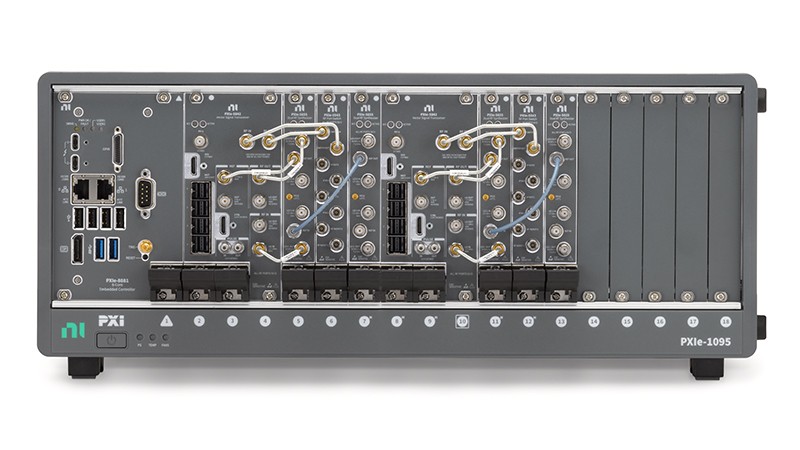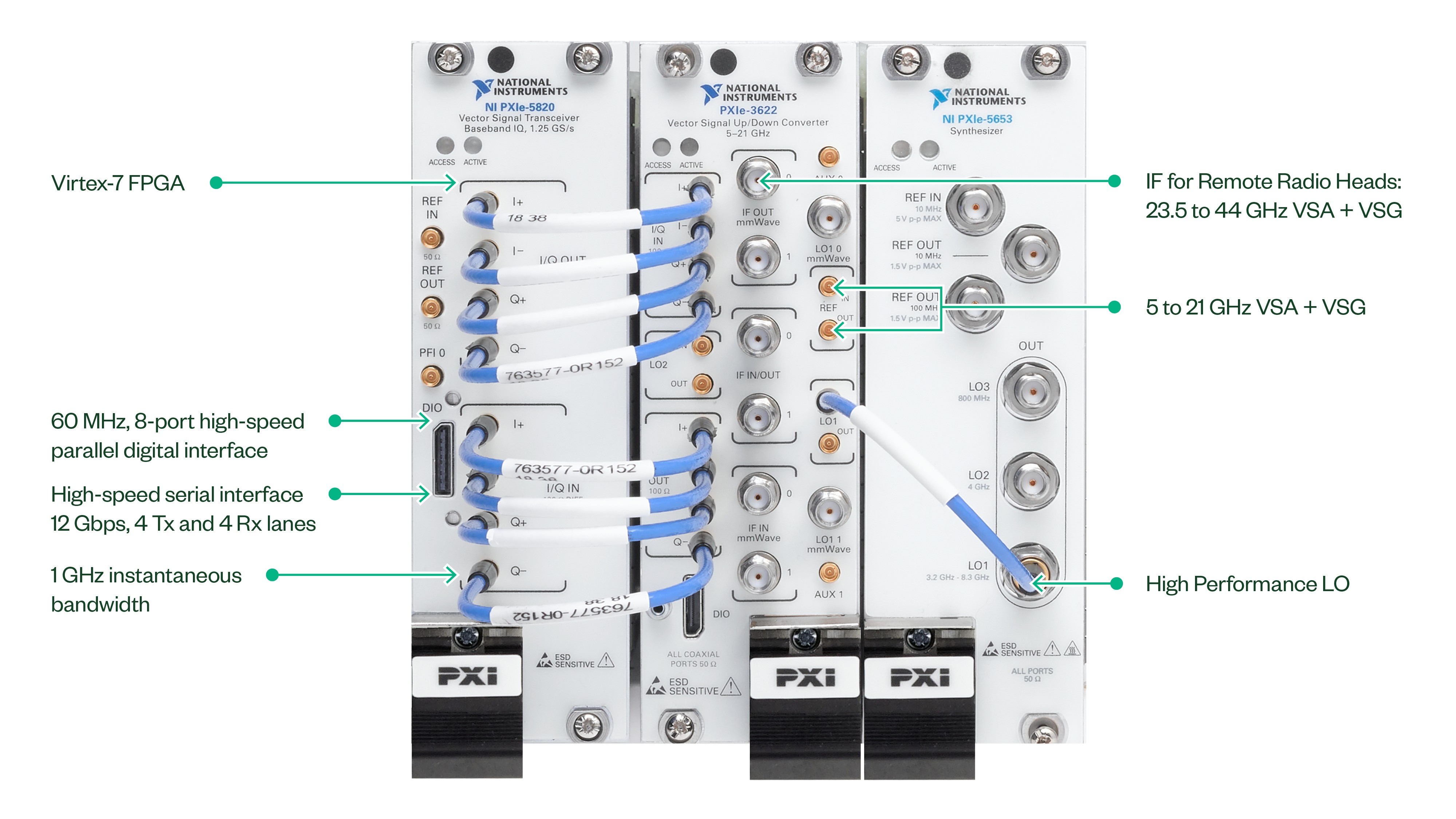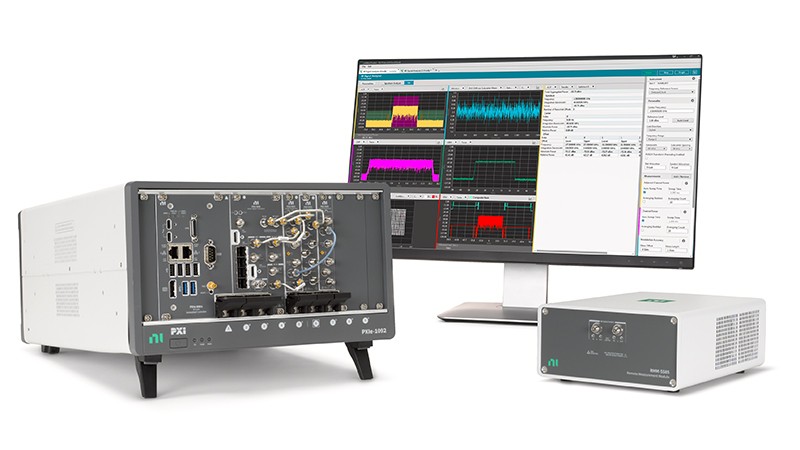Instrument Innovations for mmWave Test
Overview
Operating at millimeter wave (mmWave) frequencies brings about more complexity and the need for more versatile and accurate instrumentation in RF test applications. This is a result of more complex waveforms, an increase in test points, and restrictive link budgets that require technologies like beamforming and MIMO (multiple-input multiple-output) antenna arrays. On top of this, implementing a validation or production test strategy for new RF front ends and transceivers is often made difficult by the constant development in new wireless standards and technologies like 5G New Radio (NR).
To help you address these challenges, NI has introduced various mmWave Vector Signal Transceivers (VSTs) which deliver high-speed, high-quality measurements in an architecture that can adapt to the needs of the device under test (DUT) even as those needs are changing. The latest of these additions, the PXIe-5842 VST with 54 GHz Frequency Extension, brings new capabilities to mmWave test and is set to improve time to market with fast test times, consolidate test system requirements with fewer connections, and simplify complex mmWave test.
Contents
- Frequency Coverage from UHF into the V Band: 54 GHz Remote Measurement Module
- PXIe-5842: An Extension of the VST Architecture
- PXIe-5842 with 54 GHz Frequency Extension Features
- A Complementary VST Portfolio
- Leveraging Solutions and Software for Speed and Scalability
- PXI VST for mmWave Applications
Frequency Coverage from UHF into the V Band: 54 GHz Remote Measurement Module
At its core, the VST combines a wideband vector signal generator, vector signal analyzer, high-speed digital interface, and a powerful FPGA onto a single PXI instrument. NI’s PXIe-5842 VST can extend the VST architecture with innovations focused on addressing the increasing complexity—and uncertainty—of wireless standards, protocols, and technologies.
Figure 1: PXIe-5842 VST with 54 GHz Frequency Extension Detailed View
The PXIe-5842 VST consists of the PXIe-5842 module and the required PXIe-5655 Dual Local Oscillator (LO) Synthesizer. Occupying just four PXI Express slots, the PXIe-5842 provides continuous frequency coverage up to 23 GHz and up to 2 GHz of instantaneous RF bandwidth with excellent RF performance.
For the PXIe-5842 with 54 GHz Frequency Extension, a second PXIe-5655 dual LO synthesizer is included to provide two additional independent LOs for the two bidirectional RF ports in the RMM-5585 Remote Measurement Module. A PXIe-5443 RF Port Switch is added as well to provide connections to and from both DUT mmWave ports and DUT IF ports. In total, the mmWave configuration occupies six PXI Express slots and includes the addition of the RMM-5585 remote measurement module.
PXIe-5842: An Extension of the VST Architecture
Figure 2: PXIe-5842 with 54 GHz Frequency Extension Block Diagram
With the addition of the RMM-5585 Remote Measurement Module, the PXIe-5842 can extend frequency coverage up to 54 GHz with 2 GHz of instantaneous RF bandwidth. The RMM-5585 provides frequency conversion to and from mmWave frequencies and is cabled to the PXI-based IF subsystem. This architecture allows the mmWave interface to remain as close as possible to the DUT—which is crucial since losses at intermediate frequencies can be significantly less than those at mmWave. Shifting power delivery requirements to the lower frequencies means more power where it matters: at the mmWave test ports.
This architecture also allows for simultaneous transmit and receive operations using a single RMM-5585 in addition to independent frequency tuning, allowing for many different test configurations on a single instrument. A block diagram is shown in Figure 2.
| Specification | PXIe-5842 with 54 GHz Frequency Extension |
|---|---|
| RMM-5585 RF IN/OUT Frequency Range | 22.5 GHz – 54 GHz |
| PXIe-5543 RF IN/OUT Frequency Range | 200 MHz – 23 GHz |
| Bandwidth | 2 GHz |
| RF IN/OUT Amplitude Accuracy (23.5 - 50 GHz) | ±1.3 dB / ±1.5 dB typ |
| RF IN/OUT Frequency Response (23.5 - 50 GHz) | ±1.4 dB / ±1.2 dB typ |
| EVM (5G NR FR-2) 1CC, 100 MHz loopback, measured @ 28 GHz | - 44 dB |
| Maximum Leveled Output Power (28 GHz) | + 10 dBm typ |
Table 1: PXIe-5842 with 54 GHz Frequency Extension Specifications
The PXIe-5842 offers a wide range of features that simplify mmWave test configurations, allow for increased versatility in test coverage, and deliver high-performance RF measurements in a single, tightly synchronized PXIe instrument.
PXIe-5842 with 54 GHz Frequency Extension Features
Wide Frequency Coverage
Radio spectrum allocations are constantly changing with different bands being reserved for wireless, cellular, satellite communications, navigation, and radio astronomy. It is critical to ensure the frequency coverage necessary to develop tomorrow’s mmWave applications.
With up to a 54 GHz frequency coverage, the PXIe-5842 VST offers full spectrum coverage for WLAN, UWB, 5G FR-1—and crucially, all 5G FR-2 frequency bands (24.25 GHz to 52.6 GHz), meaning just one instrument is needed for testing across all these different standards. The high-frequency coverage also means you can use the PXIe-5842 for various aerospace and defense applications from the UHF into the V band. Applications include radar target simulation, spectrum monitoring in electronic warfare and satellite communications, or for parametric test of ESAs (Electronically Scanned Arrays) components commonly used in radar and satellite communication systems.
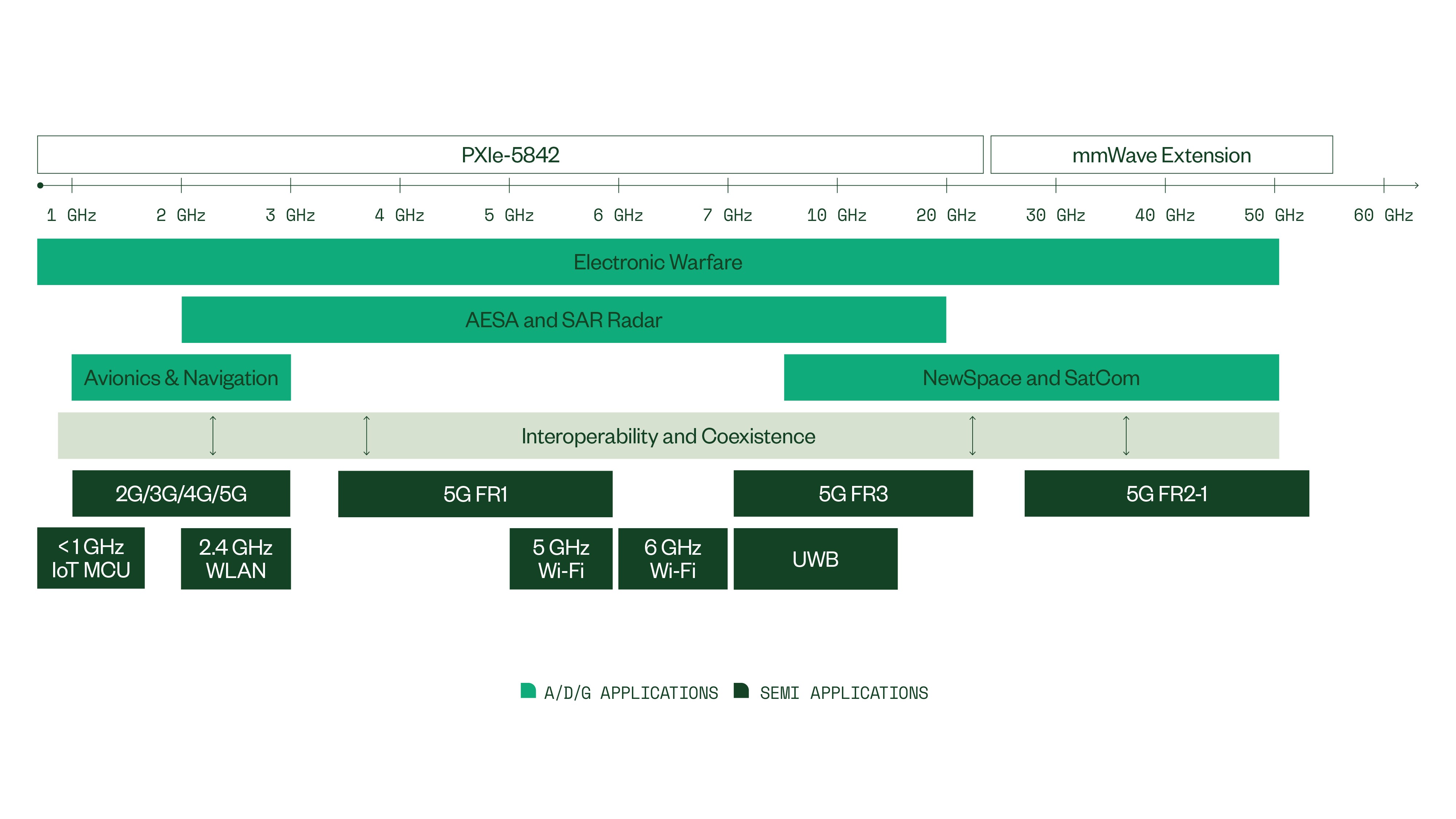
Previously, it took two VSTs to cover the entire spectrum from low frequency to mmWave. The PXIe-5842 with 54 GHz Frequency Extension can consolidate coverage onto one instrument, with the maximum frequency increasing from 44 GHz to 54 GHz while also including coverage of sub-6 GHz WLAN, cellular, IoT, and other frequency bands with the same instrument. The decreased instrumentation complexity means that you can create a single test bench able to streamline mmWave RFIC development, allowing multiple different applications and frequency bands to coexist.
Multiband Coverage with IF and mmWave Test Ports
mmWave RFICs extend the RF signal chains of today’s designs with additional steps for frequency conversion, beamforming, and phased-array radiation. An ideal test approach needs to be able to map to these test points with enough flexibility to adapt as designs and requirements evolve while being able to scale in speed and cost to meet volume demands.
Figure 4: RF to RF Bidirectional Test Setup with One Remote Measurement Module
To provide the flexibility to adapt to the varying requirements of each step in the signal chain, the PXIe-5842 VST features bidirectional test ports for both intermediate and mmWave frequencies. Bidirectional test ports eliminate the need for additional signal conditioning and switching outside the instrument and further improve measurement quality while reducing overall system complexity.
Figure 5: RF to IF Bidirectional Test Setup with One Remote Measurement Module
The PXIe-5842 includes two IF test ports that can be used independently or in conjunction with the mmWave remote measurement module. These ports provide frequency coverage from 200 MHz to 23 GHz and offer a direct interface for multifrequency devices like frequency upconverters/downconverters or beamformer ICs with built-in frequency conversion. These ports give the PXIe-5842 with 54 GHz Frequency Extension the ability to interface with multiband devices without additional instrumentation or external signal conditioning.
Up to 2 GHz of Instantaneous Bandwidth
From next-generation wireless technologies like 5G NR and 802.11be (Wi-Fi 7) to advanced aerospace and defense applications like radar test and spectrum monitoring, the demand for wider signal bandwidth to achieve higher peak data rates is growing. Leveraging fast sampling, high-linearity digital-to-analog converters (DACs) and analog-to-digital converters (ADCs), and wideband internal calibration mechanisms, the PXIe-5842 offers 2 GHz of instantaneous RF bandwidth with excellent measurement accuracy.
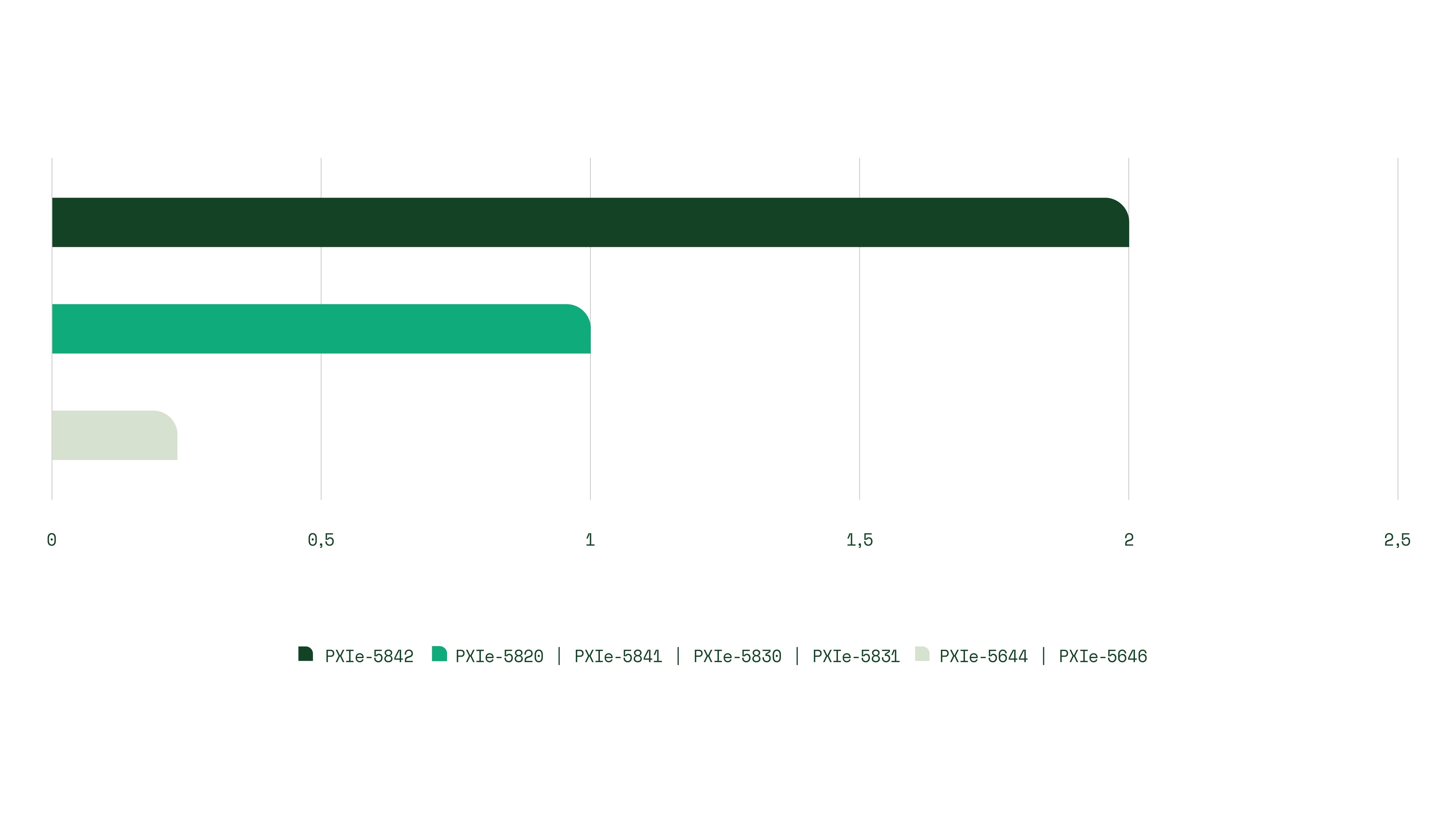
With the high instantaneous bandwidth and calibrated front ends of NI VSTs, you can effectively deploy them for demanding applications such as radar target simulation, multicarrier aggregation, digital predistortion (DPD) algorithm implementations, 5G research and prototyping, and real-time spectrum analysis. Additionally, VSTs incorporate patented algorithms for amplitude and phase correction for high absolute amplitude accuracy and low deviation from linear phase across the span of their wide instantaneous bandwidth.
Error Vector Magnitude Measurement Performance
The VST uses advanced, patented IQ calibration techniques to deliver best-in-class error vector magnitude (EVM) performance for wideband signals. A critical component of next-generation wireless devices is even more stringent EVM performance requirements over increasing bandwidths. With higher order modulation schemes and wideband multicarrier signal configurations, the RF front ends of today’s wireless devices require better linearity and phase noise to deliver the required modulation performance. Consequently, test instrumentation for wireless device test must deliver even more accurate RF performance. The PXIe-5842 offers best-in-class EVM performance for higher order modulation schemes like 5G NR.
| Center Frequency | 1 CC × 100 MHz | 2 CC × 100 MHz | 1 CC × 400 MHz | 2 CC × 400 MHz | 4 CC × 400 MHz |
|---|---|---|---|---|---|
| 28 GHz | -44.5 | -41.2 | -38.7 | -37.1 | -34.9 |
| 39 GHz | -45.3 | -41.0 | -38.4 | -36.4 | -35.8 |
| 47 GHz | -44.6 | -41.1 | -39.2 | -37.6 | -36.3 |
| 50 GHz | -44.4 | -41.0 | -38.7 | -36.8 | -34.6 |
Table 2: PXIe-5842 with 54 GHz Frequency Extension Measured EVM
Phase-Coherent Synchronization
The modular architecture of the PXIe-5842 with 54 GHz Frequency Extension and the PXI platform together provide synchronization and scaling capabilities for multichannel measurements that require phase coherence. You can achieve sub-nanosecond synchronization between two VSTs out of the box for applications like dual polarization antenna over-the-air test:
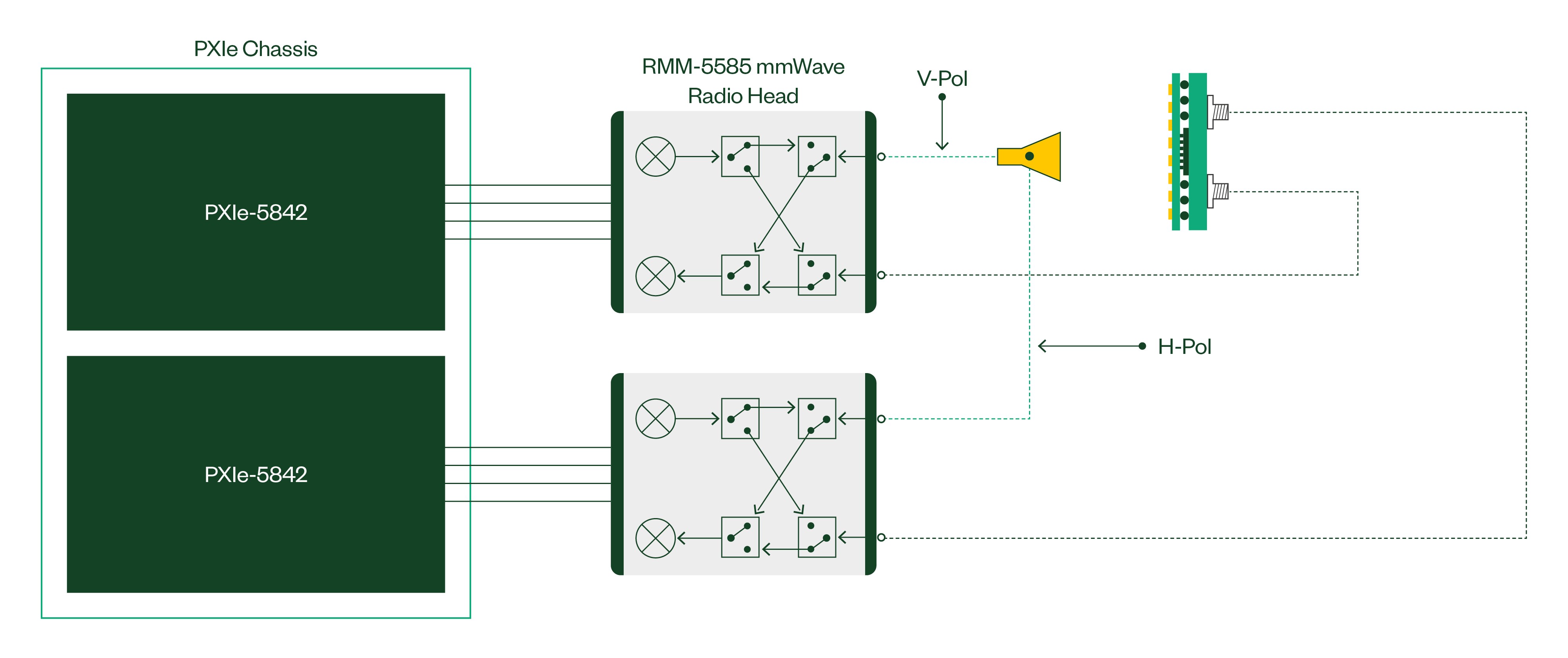
You can extend the same level of synchronization to MIMO test systems. Modern communications standards, such as 5G NR, are using MIMO schemes for many antennas on a single device to provide a combination of either higher data rates through more spatial streams or more robust communications through beamforming. Not surprisingly, MIMO technology adds significant design and test complexity. It not only increases the number of ports on a device but also introduces multichannel synchronization requirements. With its compact footprint, you can synchronize two PXIe-5842 with 54 GHz Frequency Extension VSTs in a single PXI chassis. You can further expand your systems using MXI to integrate multiple chassis as one PXI system.
Figure 8: Engineers can synchronize two PXIe-5842 with 54 GHz Frequency Extension VSTs in a single PXI chassis.
Like a single instrument, you can synchronize each VST in a completely phase-coherent manner. In hardware, a VST can synchronize each LO for the remote measurement modules and IF-based subsystem, as well as share the LO to other VSTs so that all RF system components can be synchronized. In software, you can use NI’s patented T-Clock (TClk) technology to easily synchronize multiple instruments using the NI-TClk API.
Multi-Instrument Integration with the PXI Platform
Figure 9: Multi-Instrument Integration with the NI-TClk API
Many RF test applications require additional I/O beyond RF or baseband waveform generation and analysis. This may include a power supply or source measure unit (SMU), a pattern-based digital device for DUT control, or a wide range of other analog, digital, and DC instrumentation. As part of the PXIe platform, the PXIe-5842 VST with 54 GHz Frequency Extension shares the same foundational resources with any PXIe instrument from NI to streamline test development, simplify triggering and synchronization, and maximize measurement speed. You can use the same NI-TClk technology that you use to synchronize multiple VSTs to synchronize other instruments and create a unified automated test and automated measurement solution.
A Complementary VST Portfolio
Another product in the NI family of VSTs with frequency extensions is the PXIe-5831. It has a similar PXI-based VST to remote measurement module configuration, with a few important distinctions. Based on the second generation VSTs, the PXIe-5831 offers unique switching capabilities with two mmWave radio heads connected to a single PXIe-5831. With up to 32 switched RF ports, the PXIe-5831 is well suited for test of multichannel phased arrays, beamforming architectures, and radar prototyping; and it is a useful alternative to the PXIe-5842 for these kinds of applications.
mmWave Radio Heads with Integrated Switching
Figure 10: mmWave Radio Heads with Integrated Switching: PXIe-5831
In the PXIe-5831, like in the PXIe-5842, frequency conversion to and from mmWave is performed in a remote radio head that is cabled to the PXI-based IF subsystem, extending frequency coverage up to 44 GHz for the PXIe-5831 with remote radio heads. Each mmWave radio head is available in three different configurations—2-, 9-, and 16-port—to adapt to the needs of the DUT. The additional ports are created with a switch network that is integrated in the calibration routines of the instrument, so performance specifications are accurate all the way to the test ports.
Figure 11: PXIe-5831 VST Detailed View
The choice of options when it comes to NI’s frequency extended VSTs means you can select the best option for a given application. This can enable an added level of versatility and scalability that is often necessary to maximize test efficiency.
| Specification | PXIe-5831 | PXIe-5842 |
|---|---|---|
| mmWave I/O Frequency Range | 22.5 GHz – 44 GHz | 22.5 GHz – 54 GHz |
| IF I/O Frequency Range | 5 GHz – 21 GHz | 200 MHz – 23 GHz |
| Bandwidth | 1 GHz | 2 GHz |
| mmWave Heads | 1 – 2 | 1 |
| Direct Ports | 2 unidirectional | 2 bidirectional |
| Switched Ports | Up to 32 | N/A |
| PXI Slots | 6 | 6 |
Table 3: Specification Comparison of the PXIe-5831 and PXIe-5842 with Frequency Extensions.
Leveraging Solutions and Software for Speed and Scalability
In validation and production test environments, device throughput, automation, and test time directly impact business success. The PXIe-5842 VST’s architecture of hardware and software is optimized for measurement speed without sacrificing measurement performance.
The PXIe-5842 uses many of the same software tools as previous generations of VST, ensuring a fast transition to the PXIe-5842 while enabling the same industry-leading test optimizations customers enjoyed with previous VSTs.
RFmx: Native, Speed-Optimized Driver for Common Test Development Languages
NI’s family of frequency-extended VSTs are configured and controlled by RFmx application software. RFmx provides an intuitive programming API that offers both ease of use and advanced measurement configuration for generic RF and standard-specific measurements. It features a highly optimized API to perform tasks ranging from RF spectral measurements, including channel power, adjacent channel power, and power spectrum, to measurements on digital and analog modulated signals. You can also use it to automate your programs with standard-based measurements for 5G NR, Wi-Fi 7, Bluetooth, and more.
Figure 12: 5G NR Measurements Performed Using NI RFmx in LabVIEW and .NET
Figure 12 illustrates a 5G NR-compliant channel power measurement using an RFmx LabVIEW and .NET example with just a few function calls. You can get started with one of more than 100 example programs in C, .NET, and LabVIEW that are designed to make instrument automation straightforward. The NI-RFmx API includes high-level parameters that intelligently optimize instrument settings to help you achieve the highest quality measurements with the fewest software calls. Additionally, NI-RFmx has features that vastly simplify the software complexity of multimeasurement parallelism and multi-DUT measurements. You can achieve industry-leading measurement speeds using the latest processor technologies and easy-to-program multithreaded measurements for test time reduction.
Figure 13: The VST combines a high-bandwidth vector signal generator, vector signal analyzer, high-speed digital interface, and a powerful FPGA onto a single PXI instrument. The remote measurement module extends the VST architecture with innovations focused on addressing the increasing complexity—and uncertainty—of wireless standards, protocols, and technologies.
Watch an online demo of the PXIe-5842 and how it integrates with InstrumentStudio and RFmx
PXI VST for mmWave Applications
mmWave Over-the-Air (OTA) Validation
Over-the-air (OTA) test applications can be of particular importance at mmWave frequencies. In applications like beamforming for MIMO antenna arrays, the spatial characteristics of the waveforms as well as the number of antennas used makes conducted test impractical in many situations. For these test cases, OTA test and use of an anechoic chamber is often required.
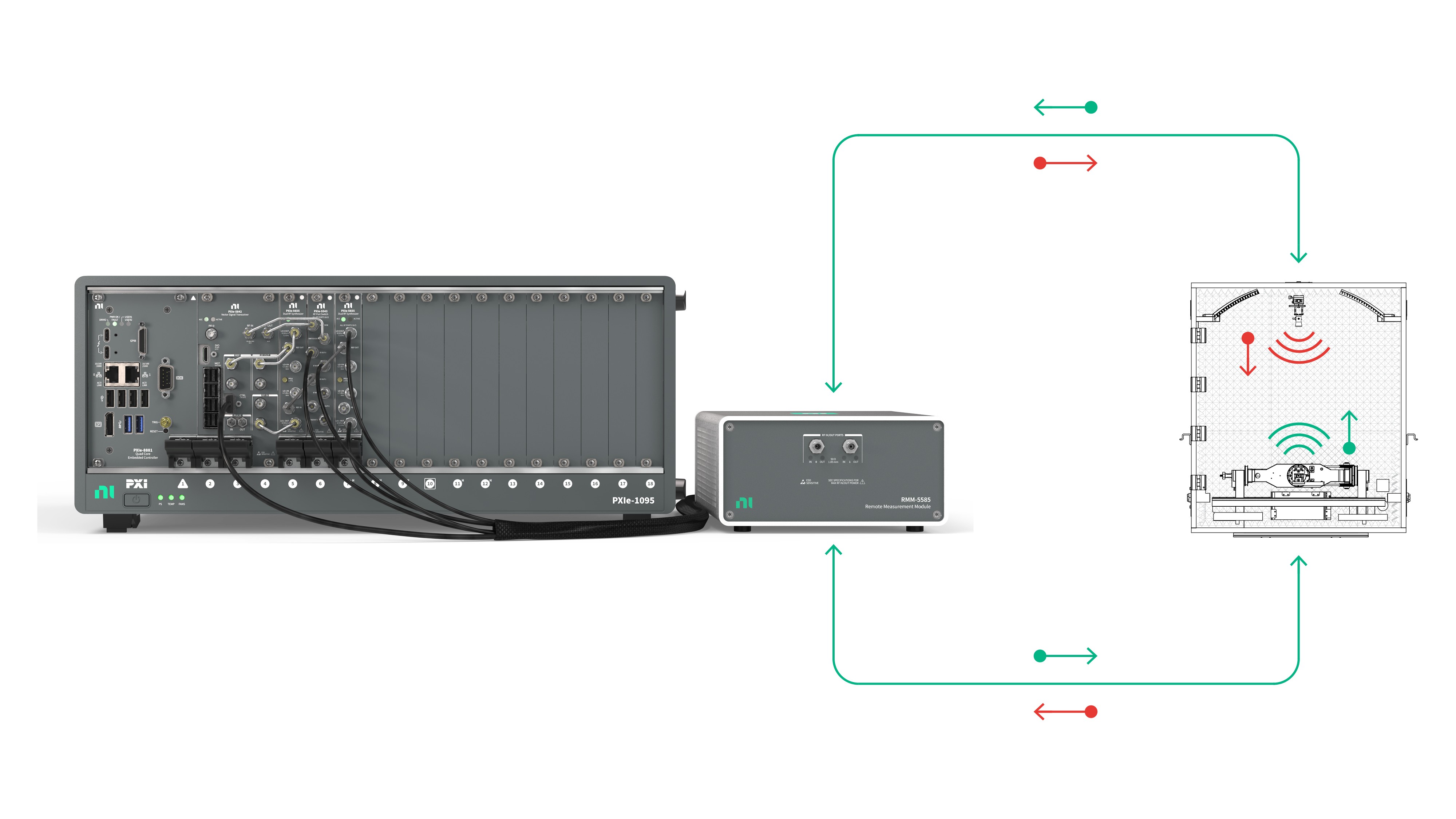
NI’s 5G mmWave OTA Validation Reference Architecture combines the PXIe-5842 with 54 GHz Frequency Extension with a cohesive set of hardware and software to streamline OTA test. The remote measurement module architecture means path loss at mmWave frequencies is minimal due to its proximity to the test chamber. The PXIe-5842 is integrated into the system in a similar manner as the PXIe-5831, meaning an easy transition from one VST to the other.
Learn more about 5G mmWave OTA Validation
RFFE Production Test
You can integrate VSTs with frequency extensions into Semiconductor Test System (STS) and other RFFE production test solutions in a similar way as the other PXI VSTs.
Learn more about NI’s solutions for high-volume RFFE production test.
Radar and Electronic Warfare (EW)
Radar and electronic warfare (EW) systems are experiencing technology disruption, as active electronically scanned arrays, ultra-wideband technology, and cognitive systems present new design and test challenges.
NI’s modular instrumentation and open software technologies give engineers the tools to deliver adaptable threat emulation with RF Vector Signal Transceiver modules and FPGA coprocessors. Scale your system-level validation to support multiple threat emitters per channel, monitor and analyze your system performance in real time, or record and playback sensitive signals securely, all on a common modular instrument platform.
You can use the NI VST for EW functional and parametric test as well system-level validation, performing multi-emitter RF threat generation, real-time signal monitoring and analysis, and wideband RF record and playback.
Learn more about NI’s solutions for Radar and Electronic Warfare.
SATCOM Telemetry and Datalink Validation System
The PXIe-5842 with 54 GHz Frequency Extension offers the same advantages and benefits for SATCOM telemetry as the standard PXIe-5842.
Learn more about NI’s solutions for SATCOM telemetry and datalink validation systems.


